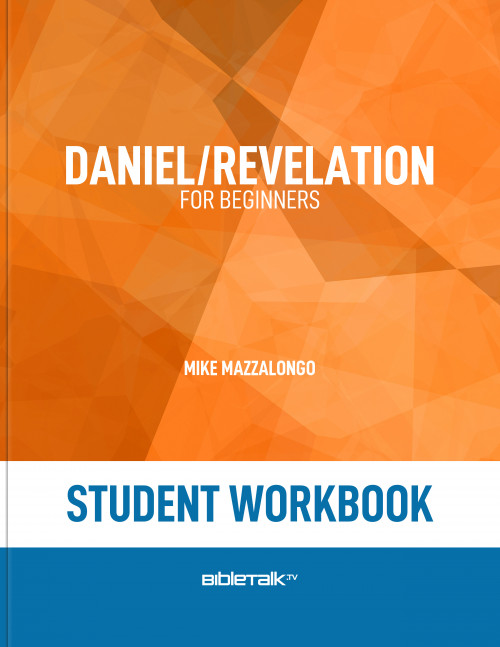Introduction to the Book of Revelation
We have completed a quick review of the book of Daniel and discussed the main interpretation of Nebuchadnezzar's dream and the subsequent visions that Daniel had that gave more detail concerning the meaning of the dream. Daniel's interpretation of Nebuchadnezzar's dream and the other visions revealed that, beginning with the world power that ruled while he was alive, there would be a total of four world empires.
During the fourth and last world empire a new spiritual kingdom would be formed by God that would replace these and remain forever. In some of his visions Daniel said that at the beginning, the spiritual kingdom would be in a great struggle with the fourth and last world power, but would eventually prevail.
Daniel also prophesied about regional wars and events that would lead to the rise and final collapse of the ancient kingdom of Judah and its capital Jerusalem, as well as the time frame for when the Messiah would come.
History has shown that Daniel's visions and prophecies were accurate: There were four great world empires that succeeded each other: Babylon, Medo-Persia, Greece and Rome.
During the Roman period the Messiah was born and fulfilled His ministry, the spiritual kingdom (church) was established and the Jewish kingdom was destroyed. It was during the Roman period that the church was persecuted but eventually overcame this persecution to spread the gospel throughout the world.
Now more than 2,000 years later none of these world empires remain, but the spiritual kingdom (the church) continues to grow throughout the world, exactly as Daniel prophesied.
You could almost say that the book of Revelation is a continuation of the book of Daniel. In it John, the Apostle, uses the same kind of apocalyptic language filled with imagery and symbolism to focus on the struggle between the fourth world power and the spiritual kingdom that Daniel spoke of long before.
Background
Author, date, place
The book of Revelation was written by John the Apostle. He names himself and the fact that God dictated it to Jesus who gave it to an angel who spoke to John. It was circulated among the churches in Asia Minor and gained early acceptance by the entire church.
John lived to an advanced age teaching and serving the church at Ephesus. He was banished to the island of Patmos in the Roman persecution of Domitian in the years 94-95 AD. It is at Patmos that he had the visions he describes in the book.
He was released from exile in 96 AD and returned to Ephesus where he wrote the book of Revelation and circulated it at first among the seven churches in that area to whom the book is addressed.
Roman history
John lived through three periods of Roman persecution.
- Nero – 64-67 AD. Nero blamed Christians for setting fire to Rome (something which he did to begin a new building program). Peter and Paul were martyred during this persecution.
- Domitian – 95-96 AD. A short but vicious persecution that took over 40,000 Christian lives and sent John to Patmos
- Trajan – 98-117 AD. This happened after Revelation was written. Trajan promoted emperor worship. The last persecution experienced by John, but not the last for the church.
There were eight other major persecutions of Christians by Rome, the last being by Diocletian in 284-305 AD. When Constantine became emperor and was converted, Christianity became the state religion by the edict of Milan in 313 AD.
John writes about the struggle between Rome and the church as prophesied by Daniel. He uses the same language of symbolism but does so to hide the meaning of the book from those who were attacking the church during his lifetime.
Content
Revelation is the only book in the New Testament that is completely devoted to prophecy. It is hard to understand because it is written in a particular literary style called apocalyptic. (Different like Shakespearean English is different than modern English)
Apocalyptic literature had certain features:
- Usually produced in times of persecution and suffering
- Had an intense despair of present circumstances and an intense hope of divine intervention in the future
- Used symbolic language, dreams, visions
- Writers used celestial characters (e.g. demons and angel) to act out God's purpose in history
- The wicked suffered catastrophic judgment, and the righteous were saved in supernatural way
- Most apocalyptic writing used the names of Biblical historical characters as authors (e.g. Enoch)
All apocalyptic writings had these characteristics including Revelation but this book names its true author, John, and he plays a part in the action of the book.
Rome and its past and future persecutions was the model for the book because most imagery of the enemy can easily be traced to Rome and its opposition to the church. For example, the "beast" with authority over every tribe and people and tongue and nation could only refer to Rome in the first century; the "mark" that all had to carry to buy or sell correlates to the imperial seal on contracts, licenses, wills and all legal documents; "Babylon", "sits on 7 hills", refers to a wicked city surrounded by seven mountains as Rome was. There are many other thinly veiled references to Rome in the book aside from these.
Regardless of how people interpret it now, the book of Revelation was seen as referring to the church's relationship with Rome when it was first read in the first century. The warning and encouragement was to stand firm against a pagan and totalitarian rule that wanted to control and then destroy the religion and thus the faith of Christians. It was also a warning to Christians who were growing lax in their moral standards and wavering in their faith.
The language and symbols used came from Old Testament imagery which would be understandable to Christians, especially Jewish Christians. The message is encoded in this way because of the persecution, so that Roman authorities would not understand the content of the material that was mostly about them.
The imagery and symbols come mostly from Daniel and Ezekiel, so that an understanding of this material is necessary if the modern reader is to correctly interpret the book of Revelation (this is why we studied the book of Daniel first).
Because the book is complex, there are many interpretations as to its meaning. These have been traditionally grouped into different "schools" of thought. Briefly, these are:
- PRETERIST SCHOOL – all symbolism refers to the first century only. No prophecy in the book.
- IDEALIST SCHOOL – the book is non-historical, it symbolizes the ongoing struggle between Christ, His church and the evil in the world.
- HISTORICIST SCHOOL – believe that the book outlines the actual history of the world from Pentecost until the second coming of Jesus. Try to interpret world events today in relationship to Revelation.
- FUTURIST SCHOOL – believe the first 3 chapters refer to the first century and the churches that existed then. The other part of the book refers to a future event they call "the great tribulation" and the symbols describe what will take place then. (Evangelicals and Charismatics believe a combination of C and D.)
In the churches of Christ, we hold that John uses the struggle between Rome and the church as a model for the ongoing struggle which will end when Christ returns. This is a combination of A and B.
Another group of ideas regarding Revelation is based on what the "1000 years" in Revelation refers to. There are three main "millennial" (1000) views.
- POST-MILLENNIAL – 1000 years is figurative of a long period of time before Jesus returns. In this view, the gospel will finally win over all the nations, there will be a period of peace and then Jesus will return.
- A-MILLENIAL – 1000 years is only figurative but Jesus will return anytime and when He does all will end, a new heaven and earth will be created. The millennial is now, the time between the establishment of the church and the end.
- PRE-MILLENNIAL – Jesus will return personally to initiate His kingdom and the saints will be raised and reign with Him on earth for 1000 years. At the end of this time Satan will rise up in rebellion and be destroyed, then the wicked will be judged and eternity begins.
Outline
There are many interpretations based on the meaning of symbols and the time and situations that the codes actually refer to. The key to understanding and outlining the book, however, is to understand that the book is about the revelation of Jesus Christ, either revealing Him and His work in the history of man or revealing His word and working out of His promises to His church.
The theme of the book is: Jesus Christ and the things He has revealed that will happen. The outline of the book is as follows:
- Prologue – Christ communicates with – John 1:1-8
- Vision I – Christ in the church on earth, 7 churches – 1:9-3:22
- Vision II – Christ in heaven – 4:1-16:21 - John's description of the heavenly activity on behalf of the church, 7 seals, 7 trumpets, 7 bowls.
- Vision III – Christ in conquest – 17:1-21:8 - The enemy defeated by Christ; contemporary Rome; end time; the antichrist; death itself.
- Christ and His church in heaven, new heaven and earth – 21:9-22:5
- Christ and His challenge to His church now, obedience, reward, fellowship – 22:6-21
The book of Revelation was not given to predict history, but rather to show the cycle of struggle and faith that the church was undergoing then and would constantly face throughout history.
It was also written to insure the reader that Christ would not abandon His church and in the end would totally save her. Each generation can relate to this constant struggle; to the ongoing support and strength provided by Christ; and every generation has the same hope and expectation that Jesus would return to destroy evil once for all and take the church to be with Him forever in heaven.
The danger is to get lost in the details and miss the central theme and message of assurance and hope.





